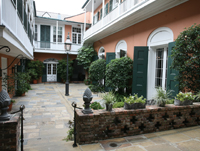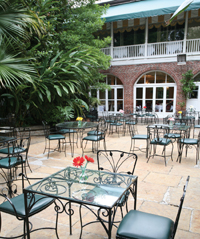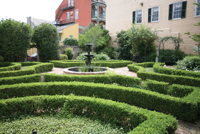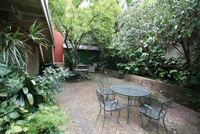Secrets of the Vieux Carré
Discover the heart of the French Quarter in its lush courtyards
 One of the things I love about the French Quarter is that it flirtatiously allows voyeurism. Whether you’re fortunate enough to live there or just strolling to a place that always seems like another country, the Vieux Carré yields its secrets in a number of ways.
One of the things I love about the French Quarter is that it flirtatiously allows voyeurism. Whether you’re fortunate enough to live there or just strolling to a place that always seems like another country, the Vieux Carré yields its secrets in a number of ways.
The architecture, which takes its inspiration from France, Spain and the West Indies, lets one peak behind heavy doors and iron gates down alleys and into the lives of those who enjoy private courtyards, which may be luminous with sun or shrouded by massive greenery.
The four courtyards shown here were selected because they are available to everyone. Sometimes you need to buy a drink, pay for a ticket or make a reservation, but these are public places of immense grace and style.
Each was laid out, with bricks, fountains and parterre gardens, after fires in the late 1700s destroyed most the city, which was then under the flag of Spain. So, today, the French Quarter is still Spanish in much of its architecture and details, adding another layer of mystery to an area that is clearly different from its surrounding neighborhoods.
Should one wish to take a tour, the Historic New Orleans Collection (535 Royal St.), which can claim two courtyards (one presently under construction), is certainly one of the best places to begin. A monumental gift to the city from the Williams family, who resided there and whose quarters are on view, the collection has more information on New Orleans than can be absorbed in years! But a knowledgeable staff and volunteers can chart your courtyard course starting with theirs. Reached from within its galleries or an elegant arched carriageway, the terraced courtyard retains its original drainage lines in the concrete. The trickle of water, which makes for a romantic sound, is from a wall fountain mounted near the residence. A classic carriage lantern lights the alleyway, as does a freestanding lamppost in the courtyard.
 The Brennan family is one of a long line of famous names to be associated with 419 Royal St. First, Adrien de Pauger, designer of the original city, had the lot, followed by painter Edgar Degas’ father, then Santiago Freret, Julian Poydras, chess player Paul Morphy, and even Tulane University. But, with the exception of temporary quarters of the Louisiana State Bank, it was never a public space. Today, millions have sipped libations in the majestic, deep-red courtyard, which looks on three sides into Brennan’s restaurant. The fountain, which curves out from the brick wall, boasts turtles for good luck and various fat little cherubs, purchased from Versailles, that peek from under palm fronds. A milk punch never hurts.
The Brennan family is one of a long line of famous names to be associated with 419 Royal St. First, Adrien de Pauger, designer of the original city, had the lot, followed by painter Edgar Degas’ father, then Santiago Freret, Julian Poydras, chess player Paul Morphy, and even Tulane University. But, with the exception of temporary quarters of the Louisiana State Bank, it was never a public space. Today, millions have sipped libations in the majestic, deep-red courtyard, which looks on three sides into Brennan’s restaurant. The fountain, which curves out from the brick wall, boasts turtles for good luck and various fat little cherubs, purchased from Versailles, that peek from under palm fronds. A milk punch never hurts.
 Above Jackson Square, in the upper Quarter, two courtyards and a garden await in the 1100 block of Chartres. Across from the Old Ursuline Convent, stands the Beauregard-Keyes House, named for Gen. P.G.T. Beauregard and Francis Keyes, both of whom resided in the yellow and white house. Adjoining it is an enclosed formal garden, which can be seen from one of three gates topped with stylistic palmetto-like ornamental iron. The formal boxwood parterre forms a lyrical pattern throughout the garden while crepe myrtles anchor an outer area and the back wall is a trellised bower for roses to shade a statue of St. Francis of Assisi. The day we arrived, the gate was open, and as we approached St. Francis, a tiny bird took flight from his shoulder
Above Jackson Square, in the upper Quarter, two courtyards and a garden await in the 1100 block of Chartres. Across from the Old Ursuline Convent, stands the Beauregard-Keyes House, named for Gen. P.G.T. Beauregard and Francis Keyes, both of whom resided in the yellow and white house. Adjoining it is an enclosed formal garden, which can be seen from one of three gates topped with stylistic palmetto-like ornamental iron. The formal boxwood parterre forms a lyrical pattern throughout the garden while crepe myrtles anchor an outer area and the back wall is a trellised bower for roses to shade a statue of St. Francis of Assisi. The day we arrived, the gate was open, and as we approached St. Francis, a tiny bird took flight from his shoulder
 Down the street is the Soniat House (1133 Chartres St.), named for the family who owned it. Today, it’s one the great small hotels of the world and spreads across both sides of the street and encompasses two buildings, both with courtyards. The landscaping is filled with small elements of surprise perfectly in keeping with the owners’ taste. The beautiful hotel rooms are complemented with antiques collected by the Rodney Smiths, who also own an antique shop adjacent to the hotel and their home. In one entrance, a long console holds antique jars while a very modern fleur-de-lis painting is hung on a column at the foot of the stairs leading to a second floor. In the other courtyard is a round iron fountain from which water playfully splashes. The rooms, of course, are private; it would be worth it to book one for the night just to wake up to the sounds of that fountain and eat breakfast in the courtyard.
Down the street is the Soniat House (1133 Chartres St.), named for the family who owned it. Today, it’s one the great small hotels of the world and spreads across both sides of the street and encompasses two buildings, both with courtyards. The landscaping is filled with small elements of surprise perfectly in keeping with the owners’ taste. The beautiful hotel rooms are complemented with antiques collected by the Rodney Smiths, who also own an antique shop adjacent to the hotel and their home. In one entrance, a long console holds antique jars while a very modern fleur-de-lis painting is hung on a column at the foot of the stairs leading to a second floor. In the other courtyard is a round iron fountain from which water playfully splashes. The rooms, of course, are private; it would be worth it to book one for the night just to wake up to the sounds of that fountain and eat breakfast in the courtyard.
The gardens and courtyards of the French Quarter are lush and verdant anytime of year. But there is something magical about them in summer … they become a respite from heat and humidity and the scent of jasmine falls heavy in the air.
